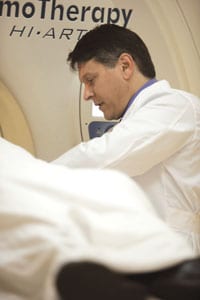Target Acquired – High-tech Advances in Radiation Therapy Save Lives
Doctors have long employed radiation as one of their tools to battle cancer. But over the past decade they’ve witnessed significant improvements in its effectiveness.
“In the last 10 years, we’ve seen a huge amount of change. We’ve seen the emergence of robotic technologies, accelerator technologies, and imaging technologies,” said Dr. Wade Gebara, director of Radiation Oncology at Berkshire Medical Center, before explaining how tomotherapy, one of the most advanced types of radiation therapy, borrows from all three advances.
“It really hit the market in the late 2000s, and now about 500 communities across the world have tomotherapy,” Gebara said. “What it enables you to do, from a clinical perspective, is target tumors deep in the body that can be seen only be seen with CT imaging.”
Tomotherapy, which delivers radiation on a narrow, slice-by-slice basis, is among the latest advances in IMRT, or intensity-modulated radiation therapy, which emerged around the turn of the 21st century. This computerized radiation-delivery method can pinpoint a cancerous area more accurately and reduce the spread of radiation to healthy tissue.
IMRT has since been enhanced by developments such as by image-guided radiation therapy (IGRT), which allows the radiologist to actually see the tumor during the procedure — helpful, because tumors can move between treatments — making the delivery of radiation an even more accurate science, and paving the way for new technologies such as tomotherapy.
“You can surround the target, blocking out nearby structures, which of course you don’t want to treat, and give a nice, homogenous dose to the target,” Gebara said. “It enables better tumor coverage within the body and enables you to drop the dose to critical structures nearby — to improve the therapeutic ratio, as doctors say.”
He said doctors talk about radiation therapy in terms of risks versus benefits, and today’s technology allows oncologists to modulate the dosage to cancerous tissue with greater precision than ever before, all while protecting healthy tissues and organs nearby.
“That’s where the big advance has been, I think, and tomotherapy is uniquely set up for this,” he told HCN. “Other robotic technologies have been coming on the market, but this is still the standard people are working toward, I would say.”
Beam Me Up
Backing up a bit, intensity-modulated radiation therapy uses computer-controlled linear accelerators to deliver precise radiation doses to a malignant tumor or specific areas within the tumor. IMRT allows for the radiation dose to conform more precisely to the actual shape of the tumor by controlling the intensity of the beam in multiple small volumes. Essentially, it allows higher radiation doses to be focused to regions within the tumor while minimizing the dose to surrounding structures.
“IMRT is basically the use of multiple radiation beams arranged around the patient,” said Dr. Brian Acker, chief of Radiology at Baystate Medical Center. “Each beam is composed of different beamlets, if you will, giving varying amounts of radiation to different parts of the tumor; the beam adds up on the patient to deliver a very precisely shaped distribution of the dose, which allows us to shape the radiation dose to cover the tumor, even tumors that are irregularly shaped, and push the dose away from important, vital structures.”
A good example is the head and neck area, where IMRT has become the standard way to treat the tumor and lymph nodes, but avoid the salivary glands, which are close by, he continued. “There is much less long-term drying of the mouth. With conventional radiation therapy, people were bone dry for the rest of their lives, which can have bad effects on the teeth.”
With IMRT, he added, “drying still occurs after head and neck radiation, but there’s a lot less. The effect has been dramatic. At the same time, cure rates have stayed the same or gotten better.”
Treatment is carefully planned by using 3-D computed tomography (CT) or magnetic resonance (MRI) images of the patient in conjunction with computerized dose calculations to determine the dose-intensity pattern that will best conform to the tumor shape. Typically, combinations of multiple fields coming from different beam directions produce a tailored radiation dose that maximizes the dose to the tumor while minimizing the effect on adjacent tissues.
These days, said Acker, IMRT is almost always used for prostate cancer and gynecological tumors, and it has been deployed in some cases of lung and esophageal cancers. Meanwhile, it’s is still evolving in a number of aspects.
“Newer ways of delivering IMRT make it much faster now,” he noted. “We’re delivering with modern accelerators, and the new ones can deliver IMRT with the machines rotating around the patient and the beamlets constantly changing, so the whole process is much quicker, much more comfortable for the patient, and with less chance of patient movement. It’s still IMRT, but a better way to do it.”
The emergence of IGRT has been a major step in getting cancer patients healthy while minimizing side effects.
“For a long time, we’ve used simple X-rays during radiation treatment to make sure targeting is accurate,” Acker said. “Now we have technology which allows the linear accelerator to be used in effect like a CT scanner. We can determine tumor shift and, therefore, shift our radiation fields, and increase the accuracy of treatment.”
Fewer Visits, Stronger Dose
Technology and delivery systems are clearly evolving, but they don’t represent the only changes to the radiation-therapy field. Take, for example, a concept called hypofractionation.
“There’s a trend in radiation therapy to use fewer, larger doses of radiation in certain situations where that has proven to be effective,” Acker said. “For many decades, radiation therapy oncologists have believed — in general correctly — that using many different treatments spread over a number of weeks is most effective in destroying cancer while decreasing side effects and protecting normal tissue, allowing them to repair on a daily basis between treatments. That has become very standard.”
However, he went on, “more recent research shows that, for certain cancers, we can get a better effect by giving a smaller number of larger fractions. For example, for prostate cancer, we might give five large fractions over two to three weeks. This is starting to show promise as an alternative to the conventional, lengthy course of treatment.
“It only applies to certain cancers; research shows it’s effective in the prostate,” he emphasized. “And we’re not talking about improving the outcome, necessarily, but greatly improving convenience.”
Certain breast cancers have also responded well to hypofractionation. “A Canadian research study showed that, after lumpectomy, this kind of treatment over three weeks may be just as effective as traditional treatment over six weeks. These are select patients — not all breast-cancer patients will get the same outcome — but for certain patients, it’s a much more convenient course of treatment.”
The third group that may benefit from hypofractionation are those with incurable cancer who are receiving radiation not for a cure, but for its palliative effects.
For example, “in the case of bone pain, a single, large radiation treatment can be as effective as multiple small doses,” Acker explained. “These are all examples where hypofractionation is proving to be effective, convenient, and less costly — which we’re all more conscious of these days, in this environment where everyone is trying to deliver high-quality care in a cost-conscious manner.”
Quantum Leap
Gebara characterized modern radiation technology as a “giant leap” compared to what his predecessor, Dr. Michael Sheridan, used.
“After the mid-’80s, not a lot happened,” he said. “There wasn’t a huge jump in technology until around 2000, which is when we started seeing robotics inch their way into the field. Now, we have even better robotic control.”
Speaking of Sheridan, “radiation technology has changed more over the past 12 years than it did his entire career up to that point,” Gebara said. “When he retired, he said he didn’t want to retire because he was so excited about all the technological change on the way.”
One of the impressive features of tomotherapy, for instance, is its ability to protect healthy tissues to an unprecedented degree, even for IMRT.
“It enables us to do a lot of things with complex retreatment cases — if a person had previous treatment to the spine, for example, and the spinal cord can only take so much dose. If they have a reoccurrence, what do you do? Tomotherapy blocks out the spinal cord and treats everything around it, like a donut-shaped radiation field.”
He said patients in the Berkshires are often surprised at the level of technology now available there to fight cancer — advances that are slowly saturating the country.
“When you talk about a rural area, one of the greatest concerns is that they’re not going to have the same quality of care as an urban area. But one thing these technologies do is bring about standardization in care,” Gebara explained. “Technology is leading to further standardization and enabling doctors, wherever we are, to essentially give the same treatment, with the same machines, you can get anywhere else.”



Comments are closed.